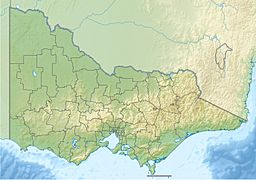Mount Disappointment (Australia) facts for kids
Quick facts for kids Mount Disappointment |
|
|---|---|
| Highest point | |
| Elevation | 800 m (2,600 ft) |
| Geography | |
| Location | Victoria, Australia |
| Parent range | Hume Range, Great Dividing Range |
| Climbing | |
| First ascent | 1824 by explorers Hume and Hovell |
Mount Disappointment is an 800-meter (about 2,600 feet) tall mountain in Victoria, Australia. It's part of the Great Dividing Range and is located about 60 kilometers (37 miles) north of Melbourne. Explorers Hamilton Hume and William Hovell gave the mountain its unique name in 1824. Today, it's a popular place for hiking and enjoying nature.
The mountain is also important because it helps supply water to the Yan Yean Reservoir. This reservoir is a major source of drinking water for the city of Melbourne.
Contents
History
How Mount Disappointment Got Its Name
Long before Europeans arrived, Aboriginal Australians lived around Mount Disappointment. They likely explored the mountain first. Stone tools have been found in the area, showing their long history there. The land around the mountain belonged to the Kulin people.
In 1824, British explorers Hamilton Hume and William Hovell made a difficult climb to the top of the mountain. They hoped to see Port Phillip Bay from the summit. However, many tall trees blocked their view, which made them very disappointed. One of the explorers also got hurt nearby, adding to their troubles. Because of these feelings, they decided to name the mountain "Mount Disappointment."
Gold and Timber
In 1870, people started mining for gold at Mount Disappointment. Later, in 1880, a company began cutting timber and running sawmills in the area. Many workers moved there, and new towns like Clonbinane and Wandong grew.
The company used two main mills, called 'Comet Mill' and 'Planet Mill'. They built a network of special tramways to carry huge logs to the mills. One part of the tramway was very steep and needed a winch to pull the heavy logs up. At its busiest, the timber industry in the area employed 420 men. Sawmilling stopped in 1939, but timber is still harvested from the Mount Disappointment area today. This is done carefully to make sure the forests can grow back.
World War II Camps
During World War II, starting in 1940, special camps were built near Mount Disappointment. These camps housed people who were considered "alien internees" and Italian prisoners of war. These prisoners helped clear land and build roads around the mountain.
After the war ended, the camps were closed. Later, some displaced people from Poland and Hungary lived there for a while. Today, the site of one of the main camps is a large cleared area. You can still see signs of old buildings, a tennis court, and a cricket pitch. It is now used as a picnic ground.
Recent Events
The Mount Disappointment Forest has faced large bushfires. Major fires happened in 1982 and again in 2009.
In 2007, a small plane crashed on Mount Disappointment. Sadly, the pilot did not survive.
In 2017, three hikers got lost in the forest and had to call for help. Many emergency workers were needed to find them quickly.
A remarkable event happened in June 2020. A 14-year-old boy named William Callaghan got lost while hiking with his family. William has autism and does not speak. After three days, a local volunteer found him alive and well. William had survived cold conditions alone in the bush. He was given clothes and chocolate and was mostly fine, apart from a few small scrapes.
Plants and Animals
The mountain is home to many tall trees, especially Mountain Ash. These trees grow well in the granite soil and where there is a lot of rain. You can also find Mountain Grey Gum trees in drier spots. Other trees like Red Stringybark, Narrow-leafed Peppermint, Long-leaved box, and Candlebark grow near waterways.
The forest is full of different kinds of birds. It also provides a home for animals like deer, wombats, and wallabies.
Fun in the Forest
Mount Disappointment is one of the easiest forest areas to visit near Melbourne. There are many fun things to do there. You can drive along the 40-kilometer (25-mile) Mount Disappointment Forest Drive. There are also various walking tracks, picnic areas, and camping sites. The forest is looked after by the Victorian Department of Sustainability and Environment.
You can drive on roads through the forest to explore. The forest also contains the remains of the old World War II internment camp, which is now a picnic spot.


